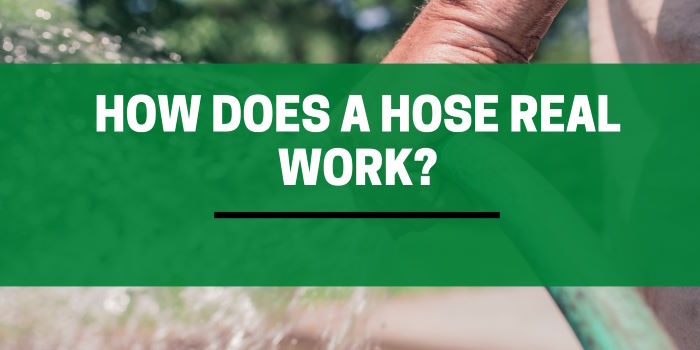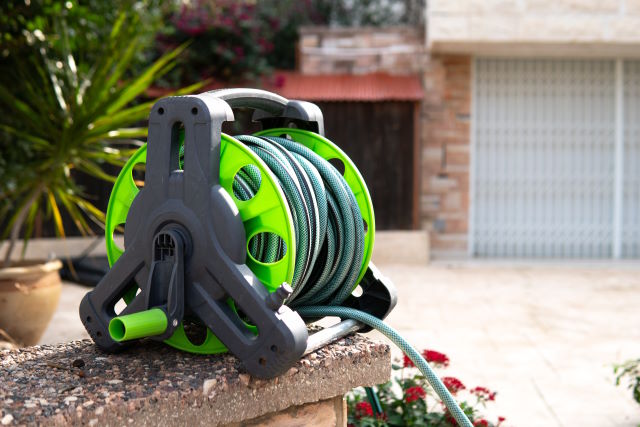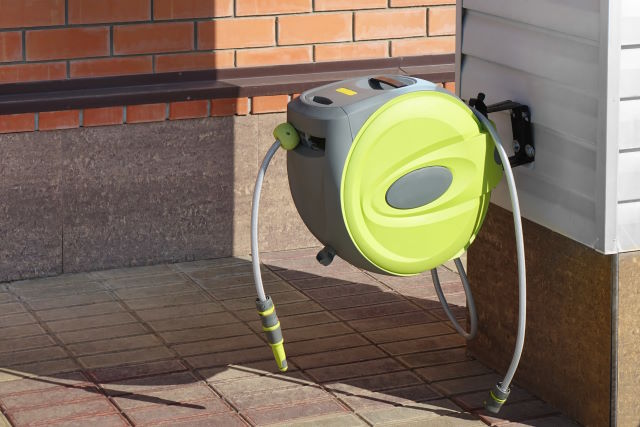
If you’ve ever used a hose in your garden or for any outdoor cleaning, you may be familiar with the frustration of dealing with a tangled, kinked, or messy hose.
In my many years tending gardens and wielding hoses, I’ve come to appreciate the elegance of a good hose reel.
Fortunately, these simple devices can solve this problem for you.
Contents
What Is A Hose Reel?
A hose reel is a cylindrical spool that is designed to hold an entire garden hose.
It makes the job of storing and using your hose easier. It’s not just about storage; it’s about preserving your sanity and back.
Hose reels come in different sizes and styles, and can be mounted on walls or placed on the ground.

Different types of hose reels are utilized for various purposes. Some are manually operated, while others are automatic and powered by electricity, water pressure, batteries, or a spring-loaded mechanism.
Internally, a reel is fed by a feeder or leader hose that is connected to the outdoor spigot. The output of a reel uses a hose coupling to connect the hose to the drum.
Types of Hose Reels
There are several types of hose reels available, each with their advantages and disadvantages. Here are some of the most common types of:
Manual Reels
Manual hose reels have a simple design and require physical effort to wind and unwind your garden hose, usually with a handle.
They are the most affordable and straightforward option but may take some effort to wind a heavy hose back in after use. So they may be inconvenient for people with physical limitations.
Automatic Reels
Automatic hose reels use various mechanisms to wind and unwind the hose with minimal effort from the user. They are normally stationary hose reels that are more expensive than manual ones but offer more convenience and ease of use.

Most use a spring mechanism that retracts the hose back at the press of a button. But there are also electronic options available,
Wall-mounted Hose Reels
Wall-mounted hose reels are designed to be attached to a wall, saving space and keeping the hose off the ground. They are available in both manual and automatic options.
Wall-mounted garden hose reels often have the benefit of being able to swivel or pivot when you move your hose around your garden. Ground-positioned reels can regularly tip over if not facing the correct direction.
Portable Hose Reels
A mobile hose reel is designed to be carried or moved on wheels around the garden, allowing for more flexibility in hose placement.
Remember that their portability relies on the length of the feeder hose.
They are usually manual and less expensive than automatic models.
Hose Reel Type Comparison
| Hose Reel Type | Pros | Cons | Cost (1 -5) |
| Manual | Cheap | Require effort to wind back | 1 |
| Automatic | Effortless winding | Higher cost | 3 |
| Wall-mounted (manual) | Space saving. Easier to wind than a floor-based manual reel. |
Still requires some effort to wind the hose | 2 |
| Wall-mounted (automatic) | Easiest to wind and unwind | Higher cost Heavy to lift and store during winter |
5 |
| Portable | Wheels offer easy mobility and storage | Portable reels with tires have a risk of puncture | 2 |
How Does a Hose Reel Work?
The basic mechanism of a hose reel is simple: the hose is wound around the spool and pulled out when needed. However, the details of how the hose is retracted depend on the type of reel.
Manual hose reels usually have a crank handle that you turn to wind or unwind the hose. Some models may also have a locking mechanism to keep the hose in place.
Automatic hose reels use various mechanisms to wind and unwind the hose with minimal effort.
Here are some of the most common mechanisms:
Water-Powered Hose Reels
Water-powered hose reels use the force of the water to wind and unwind the hose. When you turn on the water, the reel starts to rotate, winding the hose around the spool.
When you turn off the water, the reel stops rotating, keeping the hose in place.
Electric Hose Reels
Electric hose reels are powered by electricity and use a motor to wind and unwind the hose. Some models come with a remote control for easier operation.
As they require electricity from a power outlet, be sure to get one from a reputable manufacturer to reduce any safety risks.
Battery-Powered Hose Reels
Battery-powered hose reels use a rechargeable battery to power the mechanism that winds and unwinds the hose.
They are convenient to use a hose reel in an area without an electricity supply and offer more flexibility than manual hose reels.
Benefits of Using a Hose Reel
Using a hose reel has several benefits:
- Organization: A hose reel keeps your hose neatly organized and prevents tangling and kinking.
- Convenience: A hose reel makes it easier to use your hose, as you don’t have to struggle with tangling and untangling it every time you use it. An automatic reel saves time and effort to retract the hose.
- Durability: A hose reel helps to protect your hose from damage and prolong its lifespan by keeping it off the ground.
- Safety: A hose reel reduces the risk of tripping hazards and injuries caused by a tangled hose.
Choosing the Right Hose Reel
When choosing a hose reel, consider the following factors:
- Hose length: Make sure the hose reel is suitable for the length of your hose. Also, be sure that you can obtain a feeder hose of a suitable length.
- Hose diameter: Check the diameter of your hose to ensure it fits the hose reel’s spool.
- Type of hose: Some hose reels are designed for specific types of hoses, such as garden hoses, air hoses, or flat hoses.
- Manual vs. automatic: Decide whether you prefer a manual or automatic hose reel based on your budget, convenience, and physical abilities.
- Wall-mounted vs. portable: Consider where you will be using the hose reel and whether you need a wall-mounted or portable model. A portable version may be a good choice for a larger yard.
Installing a Hose Reel
Installing a hose reel is a straightforward process that can be done by most people with basic DIY skills. Here are the general steps:
- Choose a suitable location for your hose reel.
- Ensure your feeder hose is long enough to reach your desired position from your outdoor water spigot.
- Mark the mounting holes on the external wall if you’re using a wall-mounted hose reel.
- Drill holes with a masonry drill bit in the external wall and insert the screws and anchors.
- Mount the hose reel onto the screws and tighten them.
- Attach the hose to the reel, making sure it’s properly secured. Apply some lubricant to your spigot connection before attaching the feeder hose to prevent it from becoming stuck in the future.
- Turn on the water and test the hose reel to ensure it’s functioning correctly.
Maintaining Your Hose Reel
Proper maintenance of your hose reel can prolong its lifespan and ensure optimal performance. Here are some tips:
- Keep the hose reel clean and free from debris.
- Check for leaks and repair them promptly.
- Regularly lubricate the moving parts to prevent rust and wear.
- Store the hose reel in a dry and covered place during the off-season.
Common Hose Reel Problems
Like any piece of equipment, a hose reel may encounter some problems over time. Here are some of the most common issues:
- Hose kinks or tangles: This can be caused by improper storage or incorrect use of the hose reel. A high-quality hose can help to prevent this and offer long-term durability as well as taking care when the hose is retracted.
- Leaks: Leaks can be caused by a damaged hose or worn-out seals. Inserting a rubber washer or a gasket in the hose coupling can be a good choice to prevent leaks. Be sure to take correct care of your hose during winter to prevent leaks. Avoid cheap hoses to reduce the risks of leaks.
- Hose reel won’t retract: This can be caused by a jammed or twisted hose or by a malfunctioning mechanism.
- Remove your hose attachments: It’s good practice to detach your hose nozzle when not in use. This prevents the nozzle from becoming stuck and it also prevents damage during the winter months.
Troubleshooting Your Hose Reel
If you encounter any problems with your hose reel, here are some troubleshooting tips:
- Check for kinks or tangles in the hose and straighten them out before retracting the hose back to the reel.
- Inspect the hose for damage or leaks and repair or replace them promptly.
- Check the mechanism regularly for any debris, obstructions, or jammed parts and clean or replace them as necessary.
Conclusion
In summary, a hose reel is a convenient and practical tool for anyone who uses a hose regularly. It helps to keep the hose organized, untangled, and off the ground, potentially prolonging its lifespan and making it easier to use.
When choosing a hose reel, consider the hose length, diameter, type, and manual vs. automatic operation. Installing a hose reel is a simple process that can be done by most people, and proper maintenance can ensure optimal performance and longevity.
Common problems with hose reels include hose kinks or tangles, leaks, and mechanism malfunctions, but these can usually be resolved with some troubleshooting. With a little care and attention, your hose reel can be a reliable and useful tool for years to come.
Frequently Asked Questions
Can I use any type of hose with a hose reel?
No, some hose reels are designed for specific types of hoses. Make sure the hose reel is suitable for your hose before purchasing it.
How do I choose the right size of hose reel for my hose?
Choose a hose reel that is suitable for the length and diameter of your hose.
Can I mount a portable hose reel onto a wall?
It’s not recommended to mount a portable hose reel onto a wall, as it may not be sturdy enough or have strong fittings to support the weight of a heavy hose.
Can I use an automatic hose reel without electricity or batteries?
No, automatic hose reels require a power source to operate.
How often should I maintain my hose reel?
Regular maintenance is recommended to ensure optimal performance. Check the manufacturer’s instructions for specific maintenance requirements.
